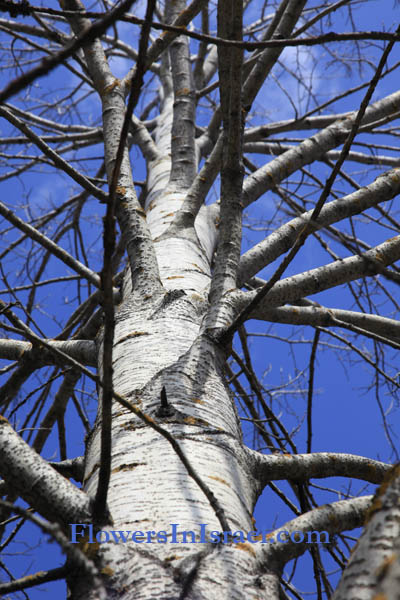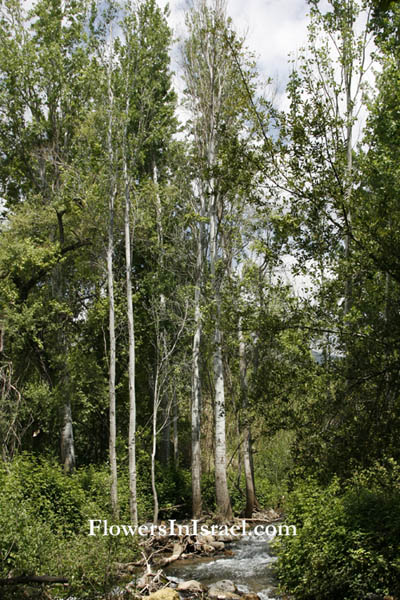
Derivation of the botanical name:
Populus may be derived from arbor populi, the people's tree, since poplars have long been planted along streets.
alba, "white, dead white; pale"; bright.
The Hebrew name: צפצפת, zaphzephet, a hapa legomenon in the Bible, of imitative origin, suggestive of the rustling of its branches; Arabic safsafah (= willow).
- The standard author abbreviation L. is used to indicate Carl Linnaeus (1707 – 1778), a Swedish botanist, physician, and zoologist, the father of modern taxonomy.
The Populus alba has deciduous leaves, shiny-green above, snowy white-woolly beneath, varying from rounded heart-shaped to ovate or ovate-oblong, sinuate-dentate, angulate, or lobed along the margins. The flowers are produced in catkins, appearing before the leaves. The young buds are covered with a resinous varnish and give off a sweet balsamic odor in the spring. On being bruised, a fragrant resin is produced. (H.N.Moldenke (1909-1996)).
H.B.Tristram, the Natural History of the Bible:"Poplar.- The Hebrew word libneh, i.e., 'white,' from the same root as Lebanon, 'the white mountain,' occurs only twice, viz. in Gen. xxx. 37, and Hos.iv. 13, and in both is translated 'poplar': Jacob took him rods of green poplar, and of the hazel and chestnut tree; and pilled white strakes in them, and made the white appear which was in the rods."..."They sacrifice upon the tops of the mountains, and burn incense upon the hills, under oaks and poplars and elms, because the shadow thereof is good". "We observed this tree very common along the banks of the Jordan, and in the lower country, and it derives its specific name from its abundance in that very country where Jacob peeled the rods (Genesis 30:37), the land of Haran, by the Euphrates and the Tigris. Hosea (Hosea 4:12-14), on the contrary, is speaking of a tree on the hills, where we did not meet with the Euphrates Poplar, but where the closely-allied species, P.alba, grows abundantly. We saw it in various parts of Galilee, Lebanon, and on Mount Hermon".
The white poplar grows only in moist ground, not on mountaintops.
The Greek Myths:
In classic Greece the groves of Academus were of poplar trees. The estate, now called the Academia, is on the river Cephissus, and six stadia distant from Athens.
Herakles brought the White poplar into Greece from Thesprotia. He found the white poplar growing on the banks of the Akheron, the river in Thesprotia, and for this reason Homer calls it Akherois.
The Thesprotian river Akheron was identified with the underworld stream, and the white poplar was the sacred tree of the god Hades.
Bitten by a poisonous snake, Hercules / Heracles found a mythical antidote in poplar leaves. The tonic is used for strangery and blood and skin diseases.
Hercules wove himself a wreath from the tree which Hades had planted. The outer leaves of this wreath remained black, because that is the color of the Underworld; but those next to Heracle's brow were bleached a silver-white by his glorious sweat. Hence the white poplar, or aspen, is sacred to him; its color signifying that he has laboured in both worlds.
The Heliades ("children of the sun"), the daughters of Helios, grieving their brother Phaëton, were changed into poplar trees and their tears into amber.
Leuce (Leukê), an Okeanid Nymph, a daughter of Oceanus, who was carried of by Pluto; and after her death, was changed into a white poplar in Elysium.
Bible Resources:
- Genesis 30:37
Jacob, however, took fresh-cut branches from poplar, almond and plane trees and made white stripes on them by peeling the bark and exposing the white inner wood of the branches.
- Isaiah 65:3
A people who continually provoke me to my very face,
offering sacrifices in gardens and burning incense on altars of brick.
- Hosea 4:13
They sacrifice on the mountaintops and burn offerings on the hills,
under oak, poplar and terebinth, where the shade is pleasant.
Therefore your daughters turn to prostitution and your daughters-in-law to adultery.
- Hosea 14:5
I will be like the dew to Israel; he will blossom like a lily.
Like a cedar of Lebanon he will send down his roots.
|

